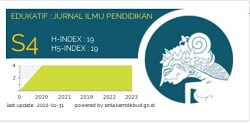PERSEPSI DOSEN TERHADAP LAYANAN APLIKASI E-LKD UIN AR-RANIRY DENGAN MENGGUNAKAN TECHNOLOGY ACCEPTENCE MODEL (TAM)
Abstract
Keywords
Full Text:
PDFReferences
Arikunto. (2006). Prosedur Penelitian Suatu Pendekatan Praktik. Jakarta: Rineka Cipta. Jakarta: Rineka Cipta.
Bodnar, G. H., & Hopwood, W. S. (2004). Acconting Informations Systems, Ninth Editions. Pearson Education International.
Fishbein, M, & Ajzen, I. (1975). Belief, attitude, intention and behavior: an introduction to theory and research.
Fishbein, Martin. (1981). leek Ajzen (1975), Belief, Attitude, Intention, and Behavior: An Introduction to Theory and Research. Read-ing, MA: Addison-Wesley.
Fishbein, Martin, & Ajzen, I. (1980). Predicting and understanding consumer behavior: Attitude-behavior correspondence. Understanding attitudes and predicting social behavior, 148–172.
Jogiyanto. (2007). Sistem Informasi Keprilakuan. Yogyakarta: CV. Andi Offset.
Lamb, H., & Hair, J. F. (n.d.). McDaniel. 2001. Pemasaran. buku, 1.
Pedoman Penilaian Kinerja Dosen UPI, 2009
Pedoman BKD Dikti, 2010
Rakhmat, J. (2007). Persepsi Dalam Proses Belajar Mengajar. Jakarta: rajawali pers.
Schierz, P. G., Schilke, O., & Wirtz, B. W. (2010). Understanding consumer acceptance of mobile payment services: An empirical analysis. Electronic commerce research and applications, 9(3), 209–216.
Sidharta, L. (1996). Internet: informasi bebas hambatan. Elex Media Komputindo.
Sugihartono, F. K. N., Harahap, F., Setiawati, F. A., & Nurhayati, S. R. (2007). Psikologi Pendidikan. Yogyakarta. UNY Press.
Sugiyono. (2010). Metode Penelitian Pendidikan. Bandung: Alfabeta.
Sunaryo. (2004). Psikologi Untuk Pendidikan. Jakarta: EGC.
Susanto, A. (2013). Sistem Informasi Akuntansi. Bandung: Lingga Jaya.
Toha, M. (2003). Perilaku Pendidikan dengan Pendekatan Baru. Bandung: PT Grafindo Persada.
Waidi. (2006). The Art of Re-engineering Your Mind for Success. Jakarta: Gramedia.
Walgito, B., & Walgito, B. (2004). Pengantar psikologi umum. Andi.
DOI: https://doi.org/10.31004/edukatif.v1i3.58
Article Metrics
Abstract view : 494 timesPDF - 231 times
Refbacks
- There are currently no refbacks.
Copyright (c) 2019 Andika Prajana, Yuni Astuti

This work is licensed under a Creative Commons Attribution-ShareAlike 4.0 International License.






1.png)